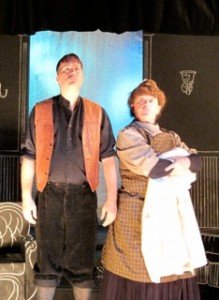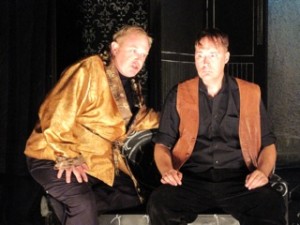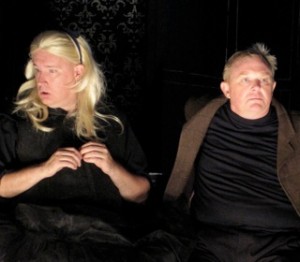
Begin as your inspiration with Alfred Hitchcock & Daphne DuMaurier’s Rebecca. (A young woman arrives at a grand and stately manor, the second wife of its handsome owner, only to be surrounded by memories of wife number one, particularly those brought up by the mansion’s housekeeper.) Add a smidgen of The Werewolf. (Among the household staff is a hunchback swineherd who turns half man/half wolf whenever there’s a full moon.) Spice with a dash of Dracula. (Another household worker is rumored to be one of those “beings who never die,” and we all know what that means.) Sprinkle in a tad of The Mummy. (Our widowed, remarried hero journeys to Cairo where his presence brings a long-dead Egyptian you-know-what back to life.) Mix all this together and the resulting soufflé is Charles Ludlam’s The Mystery Of Irma Vep, a hilarious homage to 1930s/40s Hollywood melodrama.
Following a big stage, big budget, big (Broadway) star production at San Diego’s Old Globe, Irma Vep once again weaves her unique blend of madness and merriment (this time in L.A. intimate theater mode) in an equally entertaining albeit scaled-down revival by Deconstructed Productions.
For those unfamiliar with Ludlam’s gem of a comedy-melodrama, the Mystery Of Irma Vep is not only one of the most hilarious satires ever written for the stage, it also provides two same-gendered actors the chance to deliver tour de force performances. Here the performers in question are the marvelously gifted duo of Michael Lorre and Kevin Remington, in a production directed by Lorre with considerable panache.
Irma Vep begins in the best Rebecca fashion, with housekeeper Jane Twisden (Remington) informing wooden-legged servant Nicodemus Underwood (Lorre) that their master’s new wife, Lady Enid (Remington), will “never make a fit mistress for Mandacrest. She’ll never live up to the high standards set by Lady Irma.” Clearly, asserts Jane, the second Lady Hillcrest lacks the “fine breeding and savoir faire” of Lady Irma, prompting Nic to reply, “If that French means what I think it does, you’d better wash your mouth out with soap.” Lighting flashes and thunder claps, and Nicodemus tries to put his arm around Jane. “Keep your hands to yourself,” orders the housekeeper. “You smell like a stable.” “If you slept in a table,” replies Nic, “you’d smell like one too!” And then he adds, “I’m not leaving till you give me a kiss.” “I’ll see you hanged first,” threatens Jane. “Give me a little kiss,” responds Nicodemus, “and then I’ll show you how I’m hung.”
The above exchange is just a taste of the outrageously camp sensibility of playwright Ludlam’s imaginative writing, and as other characters join the onstage action (obviously never more than two at the same time), the laughs and surprises keep coming fast and furious. Much of the play’s humor derives from a clever skewering of Victorian melodrama, as when Lord Edgar orders servant Nicodemus to take down the painting of his first wife and “burn it with the wolf!” There are plenty of dramatic fadeouts as well, for example when Nic tells Jane that the master’s killing of the aforementioned wolf is “cause for rejoicing,” and Jane responds ominously, “It’s no rejoicing there’ll be tonight, Nicodemus Underwood. He’s killed the wrong wolf!” Flash of lightning. Clap of thunder. Blackout.
There are many other delicious moments to savor. Lorre and Remington (as Lady Enid and Lord Edgar) turn a conversation made up only of each others’ names into a fully fleshed-out scene running the gamut from baby talk to passionate arousal to climactic rapture to sleep, all in less than a minute. There’s also the hilarious self-awareness of Jane telling Lady Enid that “Nicodemus can’t come … for obvious reasons” (remember that Lady Enid and Nic are both played by the same actor) and Lady Enid’s subsequent remark that “sometimes I feel that I am Nicodemus. That Nicodemus and I are one and the same person.” And how about when Jane informs her new mistress that Lord Edgar himself wore his late wife’s ball gown “when in an antic mood, in younger, happier days,” and Lady Enid replies that “any man who dresses up as a woman can’t be all bad.” Not just delicious, moments like these. Absolutely scrumptious!
Lorre and Remington write in their program notes that their goal “from the beginning has been to honor the things Ludlam honored when he wrote the piece … the silliness will take care of itself.” Thus, in place of overly exaggerated camp or burlesque “shtick,” the two actors have simply gone back to the heightened style of 1930s movie acting, and the resulting comedy is considerably funnier for not being over-the-top.
One of the greatest pleasures in attending a production of The Mystery Of Irma Vep is seeing how its two stars make Ludlam’s cast of characters their own. At the Old Globe, housekeeper Jane was very Judith Anderson in Mrs. Danvers mode. Here, Remington plays her as a cross between that Mary Poppins pair of domestics Hermione Baddeley and Reta Shaw. His Lord Edgar is less Laurence Olivier and more Rod Steiger crossed with Buddy Hackett (with a very proper British accent superimposed). Lorre, a foot or so taller than Remington, plays second wife Jane as a sort of Amazonian Alice In Wonderland, whose size make her shrieks of terror whenever thunder claps all the more amusing. He’s also a great, hulking Nicodemus, pays tribute to the many Caucasian actors who played Arab in the 1930s as Lord Edgar’s Egyptian guide Alcazar, and shows up (even more hilariously) as Pev Amri, a curvaceous, bare-breasted mummy returned to life and looking uncannily like Lady Enid.
Off-stage costume changes take place lickety-split, thanks to the very busy (and unseen) dresser Henry Senecal, actors exiting from one side of the stage and returning only instants later from the opposite side as another character.
Lorre has designed the production’s almost all-black set, with details (sconces, upholstery, etc.) sketched in in white, rather like chalk on a blackboard, and the play even begins with the two stars “completing” the design with actual chalk. (Set construction is by Levi Damione and scenic painting by Jim J. Bullock.) Remington’s costumes are appropriately black-and-white as well, and the show’s lighting (Chris Wojcieszyn is credited as lighting consultant) is suitably dramatic, footlights shining up onto faces to film noir-esque effect. Legendary Hollywood composer Franz Waxman’s scores for Rebecca and Bride Of Frankenstein make for an fittingly melodramatic musical backdrop, given Ludlam’s sources of inspiration. (Jason Duplissea is sound consultant.)
The production is performed almost prop-free, Lorre and Remington miming to perfection, whether the prop in question is a wolf carcass, a bulky historical tome, the portrait of Irma Vep hanging invisibly above the front row of seats, or (funniest of all) the harp which Lady Enid uses to accompany her occasional vocalizing. There is also an oh-so-clever use of shadow puppets, representing a ocean liner tossed on ocean waves and camels crossing desert sand dunes.
With its two master performers at the helm, this is a Mystery Of Irma Vep destined to delight audiences who manage to find it amidst the bumper crop of productions running between now and Thanksgiving. This one closes on the 11th, so haste is of the essence. Miss it, and the ghost of Irma Vep will make sure that you’re sorry you did.
The WeHoChurch Space, 916 North Formosa Ave., West Hollywood.
https://www.ovationtix.com/trs/cal/21
http://www.facebook.com/event.php?eid=1243336286
–Steven Stanley
October 1, 2009





 Since 2007, Steven Stanley's StageSceneLA.com has spotlighted the best in Southern California theater via reviews, interviews, and its annual StageSceneLA Scenies.
Since 2007, Steven Stanley's StageSceneLA.com has spotlighted the best in Southern California theater via reviews, interviews, and its annual StageSceneLA Scenies.







 COPYRIGHT 2024 STEVEN STANLEY :: DESIGN BY
COPYRIGHT 2024 STEVEN STANLEY :: DESIGN BY